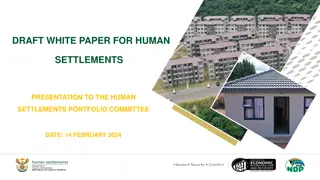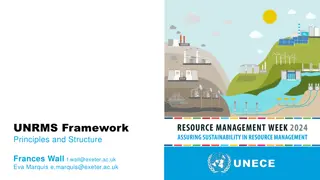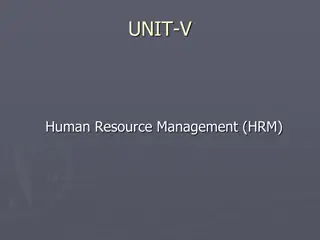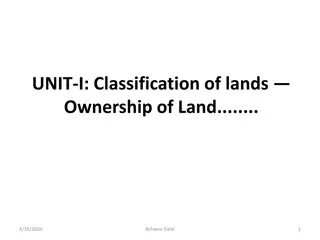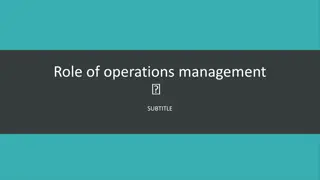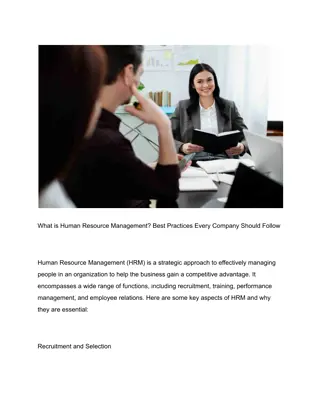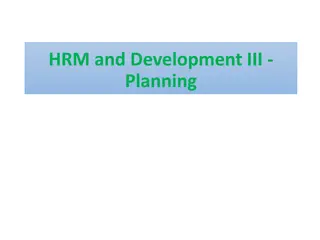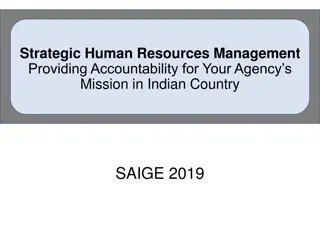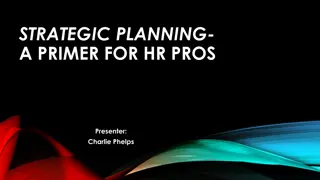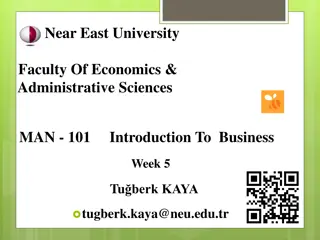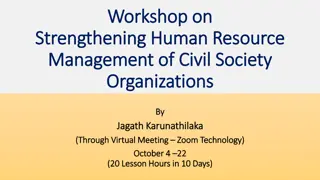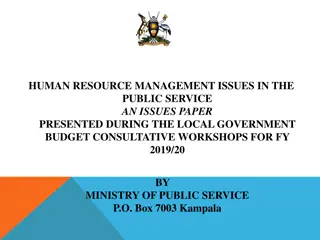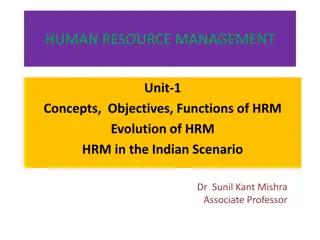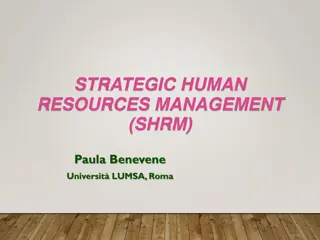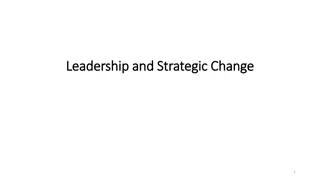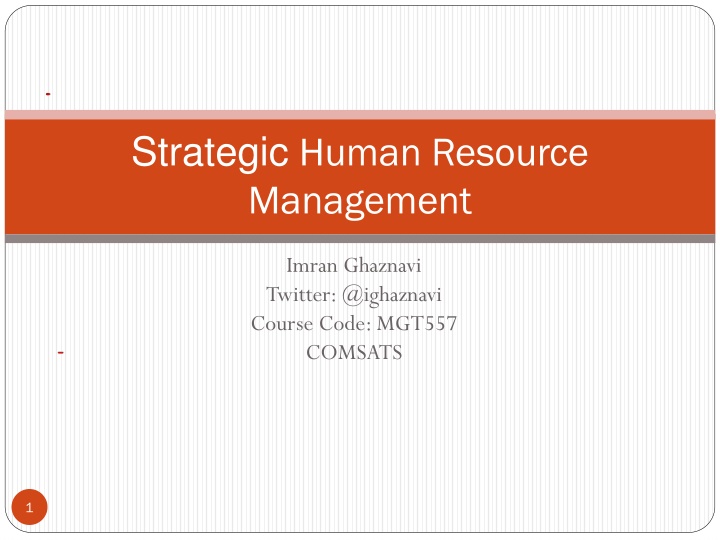
Strategic Human Resource Management Course Overview
Explore the essentials of Strategic Human Resource Management through this comprehensive course covering HR strategies, integration with business goals, and key concepts in HRM and strategy. Reference books by notable authors provide further insights into the field.
Download Presentation

Please find below an Image/Link to download the presentation.
The content on the website is provided AS IS for your information and personal use only. It may not be sold, licensed, or shared on other websites without obtaining consent from the author. If you encounter any issues during the download, it is possible that the publisher has removed the file from their server.
You are allowed to download the files provided on this website for personal or commercial use, subject to the condition that they are used lawfully. All files are the property of their respective owners.
The content on the website is provided AS IS for your information and personal use only. It may not be sold, licensed, or shared on other websites without obtaining consent from the author.
E N D
Presentation Transcript
Strategic Human Resource Management Imran Ghaznavi Twitter: @ighaznavi Course Code: MGT557 COMSATS 1
Course outline Introduction of HRM The Process Strategic Management The concept of strategic human resource management The practice of Strategic HRM HR Strategies 2
Reference books: Strategic Human Resource Management By Michael Armstrong Human Resource Management By David A. DeCenzo & Stephen P. Robbins Strategic Human Resource Management By Alan Nankervis, Robert Compton & Marian Baird 3
Strategic Human Resource Management SHRM is an approach to the development and implementation of HR strategies that are integrated with business strategies and enable the organization to achieve its goals Conceptually SHRM is to achieve fit between HR and business strategies 5
To understand Strategic Human Resource Management, it is very important to appreciate the concepts of Human Resource Management and Strategy 6
Introduction : Human Resource Management Human Resource Management It is defined as a strategic and coherent approach to the management of an organization s most valued assets the people working there, who individually and collectively contribute to the achievement of its objectives. 7
Introduction : Human Resource Management Boxall et al (2007) describe HRM as the management of work and people towards desired ends John Storey (1989) believes that HRM can be regarded as Set of interrelated policies with an ideological and philosophical underpinning 8
Human Resource Management John Storey suggests four aspects that constitute the meaningful version of HRM: 1) a particular constellation of beliefs and assumptions; 2) a strategic thrust informing decisions about people management; 3) the central involvement of line managers; and 4) reliance upon a set of levers to shape the employment relationship. 9
Human Resource Management HRM is further defined by the two models developed by what might be described as its founding fathers The matching model of HRM The Harvard framework 10
Human Resource Management The matching model of HRM One of the first explicit statements of the HRM concept was made by the Michigan School (Fombrun, Tichy and Devanna, 1984). They held that HR systems and the organization structure should be managed in a way that is congruent with organizational strategy (hence the name matching model ) 11
The matching model of HRM The model further explained that there is a human resource cycle (an adaptation of which is illustrated in Figure 1.1), which consists of four generic processes or functions that are performed in all organizations. These are: Selection matching available human resources to jobs; Appraisal performance management; Rewards the reward system is one of the most under- utilized andmishandled managerial tools for driving organizational performance ; it must reward short- as well as long-term achievements, bearing in mind that business must perform in the present to succeed in the future ; Development developing high-quality employees. 12
Human Resource Management The Harvard framework The other pioneers of HRM were the Harvard School of Beer et al (1984), who developed Harvard framework . Human resource management involves all management decisions and action that affect the nature of the relationship between the organization and its employees its human resources. 14
The Harvard framework The Harvard school suggested that HRM had two characteristic: 1) line managers accept more responsibility for ensuring the alignment of competitive strategy and personnel policies; 2) personnel has the mission of setting policies that govern how personnel activities are developed and implemented in ways that make them more mutually reinforcing. 15
The Harvard framework According to Boxall (1992) the advantages of this model are: It incorporates recognition of a range of stakeholder interests; It recognizes the importance of trade-offs , either explicitly or implicitly, between the interests of owners and those of employees as well as between various interest groups; It widens the context of HRM to include employee influence , the organization of work and the associated question of supervisory style; It acknowledges a broad range of contextual influences on management s choice of strategy It emphasizes strategic choice it is not driven by situational or environmental determinism. 17
The Importance of Human Resource Management (HRM) As a necessary part of the organizing function of management Selecting, training, and evaluating the work force As an important strategic tool HRM helps establish an organization s sustainable competitive advantage. Adds value to the firm High performance work practices lead to both high individual and high organizational performance. 19
Examples of High-Performance Work Practices Self-managed teams Decentralized decision making Training programs to develop knowledge, skills, and abilities Flexible job assignments Open communication Performance-based compensation Staffing based on person job and person organization fit o Source: Based on W. R. Evans and W. D. Davis, High-Performance Work Systems and Organizational Performance: The Mediating Role of Internal Social Structure, Journal of Management, October 2005, p. 760. 20
The HRM Process Functions of the HRM Process Ensuring that competent employees are identified and selected. Providing employees with up-to-date knowledge and skills to do their jobs. Ensuring that the organization retains competent and high-performing employees who are capable of high performance. 21
Human Resource Management Process 22
Environmental Factors Affecting HRM Employee Labor Unions Organizations that represent workers and seek to protect their interests through collective bargaining. Collective bargaining agreement A contractual agreement between a firm and a union elected to represent a bargaining unit of employees of the firm in bargaining for wage, hours, and working conditions. Governmental Laws and Regulations Limit managerial discretion in hiring, promoting, and discharging employees. Affirmative Action: the requirement that organizations take proactive steps to ensure the full participation of protected groups in its workforce. 23
Managing Human Resources Human Resource (HR) Planning The process by which managers ensure that they have the right number and kinds of people in the right places, and at the right times, who are capable of effectively and efficiently performing their tasks. Helps avoid sudden talent shortages and surpluses. Steps in HR planning: Assessing current human resources Assessing future needs for human resources Developing a program to meet those future needs 24
Current Assessment Human Resource Inventory A review of the current make-up of the organization s current resource status Job Analysis An assessment that defines a job and the behaviors necessary to perform the job Knowledge, skills, and abilities (KSAs) Requires conducting interviews, engaging in direct observation, and collecting the self-reports of employees and their managers. 25
Current Assessment (contd) Job Description A written statement of what the job holder does, how it is done, and why it is done. Job Specification A written statement of the minimum qualifications that a person must possess to perform a given job successfully. 26
Meeting Future Human Resource Needs Supply of Employees Demand for Employees Factors Affecting Staffing Strategic Goals Forecast demand for products and services Availability of knowledge, skills, and abilities 27
Recruitment and Decruitment Recruitment The process of locating, identifying, and attracting capable applicants to an organization Decruitment The process of reducing a surplus of employees in the workforce of an organization E-recruiting Recruitment of employees through the Internet Organizational web sites Online recruiters 28
Selection Selection Process The process of screening job applicants to ensure that the most appropriate candidates are hired What is Selection? An exercise in predicting which applicants, if hired, will be (or will not be) successful in performing well on the criteria the organization uses to evaluate performance. Selection errors: Reject errors for potentially successful applicants Accept errors for ultimately poor performers 30
Selection Tools Application Forms Written Tests Performance Simulations Interviews Background Investigations Physical examinations 31
Written Tests Types of Tests Intelligence: how smart are you? Aptitude: can you learn to do it? Attitude: how do you feel about it? Ability: can you do it now? Interest: do you want to do it? Legal Challenges to Tests Lack of job-relatedness of test items or interview questions to job requirements Discrimination in equal employment opportunity against members of protected classes 32
Performance Simulation Tests Testing an applicant s ability to perform actual job behaviors, use required skills, and demonstrate specific knowledge of the job. Work sampling Requiring applicants to actually perform a task or set of tasks that are central to successful job performance. Assessment centers Dedicated facilities in which job candidates undergo a series of performance simulation tests to evaluate their managerial potential. 33
Other Selection Approaches Interviews Although used almost universally, managers need to approach interviews carefully. Background Investigations Verification of application data Reference checks: Lack validity because self-selection of references ensures only positive outcomes. Physical Examinations Useful for physical requirements and for insurance purposes related to pre-existing conditions. 34
Other Selection Approaches (contd) Realistic Job Preview (RJP) The process of relating to an applicant both the positive and the negative aspects of the job. Encourages mismatched applicants to withdraw. Aligns successful applicants expectations with actual job conditions; reducing turnover. 35
Summery of the lecture Human Resource Management HRM Models HRM Process 36
Thank you For any question or query contact through twitter: @ighaznavi 37


